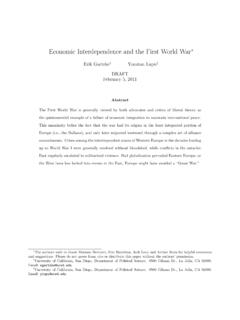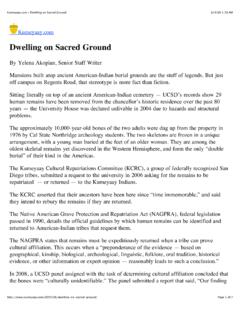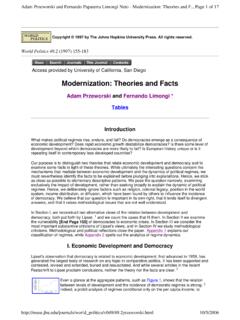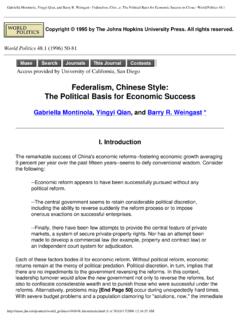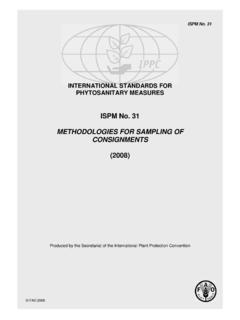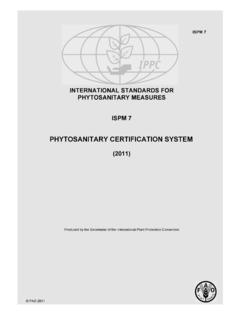Transcription of WTO Efforts to Manage Differences in National Sanitary and ...
1 UCIAS Edited Volume 1. Dynamics of Regulatory Change: How Globalization Affects National Regulatory Policies Year Article . WTO Efforts to Manage Differences in National Sanitary and phytosanitary Policies David G. Victor Stanford University This article is part of the University of California international and Area Studies Digital Collection. Copyright 2002. c by the authors. WTO Efforts to Manage Differences in National Sanitary and phytosanitary Policies Abstract The Sanitary and phytosanitary (SPS) Agreement of the World Trade Or- ganization is the centerpiece of global efforts to restrain governments from im- posing non-tariff barriers on trade in foods and other products that could affect human, plant an animal safety. It is designed to prevent proliferation of such non-tariff trade barriers while, at the same time, allowing governments flexi- bility to impose restrictions for legitimate purposes.
2 This article reviews the design of the SPS Agreement and its actual operation during the first five years of the WTO; it focuses on the three formal disputes over application of the SPS. Agreement that were prosecuted within the WTO Dispute Settlement system. It argues that it has proved difficult, within the framework of the SPS Agreement, to draw a sharp distinction between legitimate and illegitimate application of SPS policies. Moreover, the article concludes that there is little evidence that attempts to reduce SPS-related non-tariff trade barriers has led to a race to the bottom or, generally, a reduction in the stringency of SPS policies in WTO. member governments. KEYWORDS: Comparative Studies Victor: WTO Efforts to Manage Differences in National Sanitary and Phytos INTRODUCTION.
3 One measure of the success of the postwar trading system is that tariff trade barriers have declined sharply. But the reduction in tariffs has exposed the many non-tariff barriers that remain, and in many cases governments have kept protectionism in place by simply shifting from tariff to non-tariff measures. Included in the broad category of non-tariff barriers are differences in technical standards such as labeling requirements and environmental regulations. The focus in this paper is on one subset of these technical barriers: measures for Sanitary (animal, including human) and phytosanitary (plant) protection. Such rules include import bans that are intended to prevent pests from moving across borders along with trade goods, fumigation regimes that are intended to kill harmful pathogens, and sundry other systems.
4 Sanitary and phytosanitary (SPS) measures often have huge effects on trade; yet managing them is not easy. SPS measures vary across and within nations because preferences and circumstances vary. Simply requiring nations to harmonize the SPS measures to a single standard is neither technically nor politically feasible in the global context. Some nations seek tight protection while others readily consume riskier foods; some pristine environments are vulnerable to pest infestations and require elaborate quarantines for imported products, but other countries are already overrun with pests. It would be difficult to design a single set of international standards that could accommodate such varied preferences and circumstances. Even if that were technically possible it would be politically impossible in the global context because harmonization of standards would transfer political power to international institutions.
5 The 1994 World Trade Organization (WTO) Agreement on the Application of Sanitary and phytosanitary Measures ( SPS Agreement ) is the most significant global effort to reduce trade distortions caused by differences in National SPS protection policies. The negotiations leading to that agreement rejected harmonization as technically and politically infeasible;. instead, the architects of the SPS Agreement sought to strike a balance between the need to accommodate differences in local preferences and circumstances while also barring SPS. measures that are merely impediments to trade. The Agreement urges the use of international standards as benchmarks but allows countries to deviate from international standards provided that National SPS policies are based on risk assessment and meet other criteria.
6 *. Final text, 25 February 2002. Thanks to Steve Charnovitz, Bob Kagan, David Vogel, an anonymous reviewer, and members of the project for helpful comments. When this essay was written, DGV was Robert W. Johnson, Jr., Fellow for Science and Technology, Council on Foreign Relations. Now he Adjunct Senior Fellow at the Council and Director, Program on Energy and Sustainable Development, Stanford University, Encina Hall E416, Stanford, CA. 94305, tel: 1-650-724-1712, fax: 1-650-724-1717, email This article is based heavily on a law review article on the same topic: David G. Victor, 2000. The Sanitary and phytosanitary Agreement of the World Trade Organization: An assessment after five years, . New York University Journal of international Law and Politics, vol.
7 32, No. 4 (summer), pp. 865-937. Produced by The Berkeley Electronic Press, 2009. UCIAS Edited Volumes Vol. 1 [2002], Article 7. This paper examines the first five years' operation of the SPS Agreement and explores the three questions raised in the introduction to this book: (1) Are the rules of the SPS Agreement having an effect on National standards ? (2) Is the Agreement leading to harmonization of National SPS policies or diversity? (3) Is the Agreement leading to National SPS policies that are stricter ( trading up ) or weaker ( trading down )? The answers will help improve the debate about globalization. international free trade agreements, such as those in the WTO, are designed to promote globalization. international agreements are also often cited as the best remedy for the ills of globalization, such as the fear that fully free trade will lead to a race to the bottom.
8 The SPS Agreement is one of the few in the are of trade and the environment where there is some track record that makes it possible to determine whether agreements are fostering or hindering trade, and whether they are also harmonizing or changing the stringency of National SPS protections. In brief, I argue that the effect of the SPS Agreement on National regulatory standards has been remarkably small. Benchmarking appears to be having little effect because the SPS. Agreement allows countries to deviate from international benchmarks provided that the process by which countries set their SPS measures meets certain minimum standards . In particular, the SPS Agreement is requiring that countries establish a rational relationship between assessments of SPS risks and the measures that they impose.
9 Moreover, it has required that they impose comparable levels of SPS protection in comparable situations. In practice, these process requirements have been vague and elastic. They have probably led to the use of SPS measures that are less restrictive of trade, but they have had no significant effect on the level of SPS. protection. Indeed, the SPS Agreement was designed so that it would not require countries to reduce (or increase) their level of SPS protection. In a few cases countries are removing highly restrictive SPS measures, but doing so has had no appreciable effect on SPS protection. The rational relationship test is probably leading to more use of risk assessment and greater attention to risk management, which may lead to more diversity in SPS measures and levels but no systematic trend toward tighter or looser SPS measures.
10 Neither trading up nor trading down is observed. The SPS Agreement is still young and there are no other global examples of this strategy with which to make useful comparisons. The approach taken here is to examine the major elements of the SPS Agreement and the three international SPS standard-setting processes that are explicitly mentioned in the SPS Agreement (section I). Then I review the major elements and decisions of the three WTO disputes that have concerned SPS measures, which help reveal how the WTO system is interpreting the SPS Agreement (section II). Finally, I explore a few conclusions that emerge (section III). I. THE SPS AGREEMENT: MAJOR ELEMENTS. The basic obligations for members of the world trading regime have not changed since the first GATT agreement in 1947: members must give equal treatment to exports from all members, and members are barred from discriminating between locally produced and imported 2.
